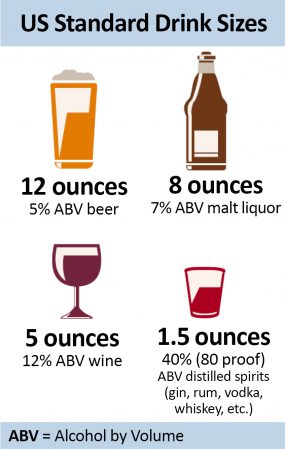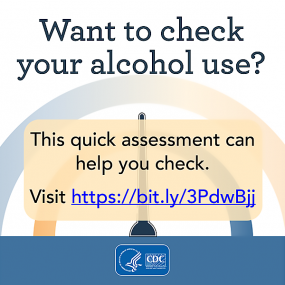Dietary Guidelines for Alcohol
- Alcohol consumption is associated with a variety of short- and long-term health risks, including motor vehicle crashes, violence, sexual risk behaviors, high blood pressure, and various cancers (e.g., breast cancer).1
- The risk of these harms increases with the amount of alcohol you drink. For some conditions, like some cancers, the risk increases even at very low levels of alcohol consumption (less than 1 drink).2,3
- To reduce the risk of alcohol-related harms, the 2020-2025 Dietary Guidelines for Americans recommends that adults of legal drinking age can choose not to drink, or to drink in moderation by limiting intake to 2 drinks or less in a day for men or 1 drink or less in a day for women, on days when alcohol is consumed.4 The Guidelines also do not recommend that individuals who do not drink alcohol start drinking for any reason and that if adults of legal drinking age choose to drink alcoholic beverages, drinking less is better for health than drinking more.4

- Two in three adult drinkers report drinking above moderate levels at least once a month.5
People Who Shouldn’t Drink At All
The Guidelines note that some people should not drink alcohol at all, such as:
- If they are pregnant or might be pregnant.
- If they are younger than age 21.
- If they have certain medical conditions or are taking certain medications that can interact with alcohol.
- If they are recovering from an alcohol use disorder or if they are unable to control the amount they drink.4
The Guidelines also note that not drinking alcohol also is the safest option for women who are lactating. Generally, moderate consumption of alcoholic beverages by a woman who is lactating (up to 1 standard drink in a day) is not known to be harmful to the infant, especially if the woman waits at least 2 hours after a single drink before nursing or expressing breast milk. Women considering consuming alcohol during lactation should talk to their healthcare provider.4 Learn more about breastfeeding and alcohol use.

Science around Moderate Alcohol Consumption
- The Guidelines note, “Emerging evidence suggests that even drinking within the recommended limits may increase the overall risk of death from various causes, such as from several types of cancer and some forms of cardiovascular disease. Alcohol has been found to increase risk for cancer, and for some types of cancer, the risk increases even at low levels of alcohol consumption (less than 1 drink in a day).”4
- Although past studies have indicated that moderate alcohol consumption has protective health benefits (e.g., reducing risk of heart disease), recent studies show this may not be true.6-12 While some studies have found improved health outcomes among moderate drinkers, it’s impossible to conclude whether these improved outcomes are due to moderate alcohol consumption or other differences in behaviors or genetics between people who drink moderately and people who don’t.6-12
- Most U.S. adults who drink don’t drink every day.13 That’s why it’s important to focus on the amount people drink on the days that they drink. Even if women consume an average of 1 drink per day or men consume an average of 2 drinks per day, binge drinking increases the risk of experiencing alcohol-related harm in the short-term and in the future.14
- Drinking at levels above the moderate drinking guidelines significantly increases the risk of short-term harms, such as injuries, as well as the risk of long-term chronic health problems, such as some types of cancer.1,15,16
- Centers for Disease Control and Prevention. Alcohol Use and Your Health Web Page. Accessed April 18, 2022.
- Di Castelnuovo A, Costanzo S, Bagnardi V, Donati M, Iacoviello L, de Gaetano G. Alcohol dosing and total mortality in men and women. Arch Intern Med 2006;166(22):2437-45.
- Rehm J, Shield K. Alcohol consumption. In: Stewart BW, Wild CB, eds. World Cancer Report 2014. Lyon, France: International Agency for Research on Cancer; 2014
- U.S. Department of Agriculture and U.S. Department of Health and Human Services. 2020 – 2025 Dietary Guidelines for Americans. 9th Edition, Washington, DC; 2020.
- Henley SJ, Kanny D, Roland KB, et al. Alcohol control efforts in comprehensive cancer control plans and alcohol use among adults in the United States. Alcohol Alcohol 2014;49(6):661-7.
- Chikritzhs T, Fillmore K, Stockwell T. A healthy dose of skepticism: four good reasons to think again about protective effects of alcohol on coronary heart disease. Drug Alcohol Rev 2009;28:441–4.
- Andréasson S, Chikritzhs T, Dangardt F, Holder H, Naimi T, Stockwell T. Evidence about health effects of “moderate” alcohol consumption: reasons for skepticism and public health implications.[PDF-9.44 MB] . In: Alcohol and Society 2014. Stockholm: IOGT-NTO & Swedish Society of Medicine, 2014.
- Knott CS, Coombs N, Stamatakis E, Biddulph JP. All cause mortality and the case for age specific alcohol consumption guidelines: pooled analyses of up to 10 population based cohorts. BMJ 2015;350:h384.
- Holmes MV, Dale CE, Zuccolo L, et al. Association between alcohol and cardiovascular disease: Mendelian randomisation analysis based on individual participant data. BMJ 2014;349:g4164
- Naimi TS, Brown DW, Brewer RD, et al. Cardiovascular risk factors and confounders among nondrinking and moderate-drinking US adults. Am J Prev Med 2005;28(4):369–73.
- Rosoff DB, Davey Smith G, Mehta N, Clarke TK, Lohoff FW. Evaluating the relationship between alcohol consumption, tobacco use, and cardiovascular disease: A multivariable Mendelian randomization study. PLoS Med 2020;17:e1003410.
- Biddinger KJ, Emdin CA, Haas ME, et al. Association of habitual alcohol intake with risk of cardiovascular disease. JAMA Netw Open 2022;5(3):e223849.
- Naimi TS. “Gray area” alcohol consumption and the U.S. Dietary Guidelines: a comment on Dawson and Grant. J Stud Alcohol Drug 2011;72:687.
- Holahan CJ, Holahan CK, Moos RH. Binge drinking and alcohol problems among moderate average-level drinkers. Am J Prev Med 2022 (in press);10.1016.
- Vinson DC, Maclure M, Reidinger C, Smith GS. A population-based case-crossover and case-control study of alcohol and the risk of injury. J Stud Alcohol Drugs 2003;64:358-66.
- Nelson DE, Jarman DW, Rehm J, et al. Alcohol-attributable cancer deaths and years of potential life lost in the United States. Am J Public Health 2013;103(4):641-8.
Page last reviewed: April 19, 2022
